This C-47 started life in October 1943 in California as a C-47A-65-DL, “DL” signifying that she was built at the Douglas Long Beach plant. After acceptance by the USAAF with serial number; 42-100521 she was ferried east to prepare for overseas assignment. Once this was completed the aircraft was assigned to the 436th Troop Carrier Group’s (TCG) 79th Troop Carrier Squadron (TCS) with a crew consisting of; Lt. William K. Watson, pilot, who flew her throughout his time in the European Theater of Operations, with Lt. Frank P. Bibas temporarily acting as Co-pilot and Lt. Arthur E. Thornton as Navigator.
On 27th of December the aircraft departed Morrison Field, Palm Beach for England along the Southern Ferry Route stopping at Borinquen Field, Puerto Rico, then Atkinson Field, British Guyana, Belem in Brasil, on to Recife’s Iburia Field where they prepared for the long crossing to Ascension Island which they reached around New Year’s Day 1944. Roberts field, Liberia was the first destination on the East side of the Atlantic before flying on to Refisque, near Dakar then Marrakesh before flying across the Bay of Biscay while trying not to attract the attention of marauding Junkers 88s to St. Mawgan in Cornwall.
The aircraft and crew’s new ‘home’ was at Bottesford, Nottinghamshire on the Jan 7th 1944 as part of the US 9th Army Air Force Troop Carrier Command in the European Theater of Operations in the 53rd Troop Carrier Wing. The 79th TCS of the 436th TCG was under the command of Col. Adriel N. Williams and as a part of the squadron the aircraft was marked with the 79th’s designator ‘S6’ and the ship letter ‘D’ applied to the fin see photo right.
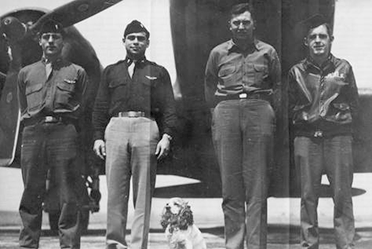
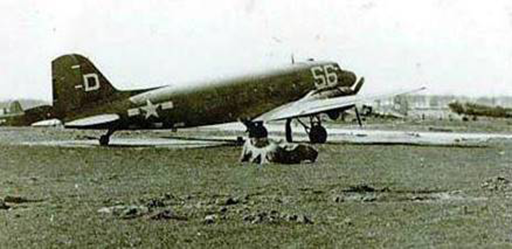
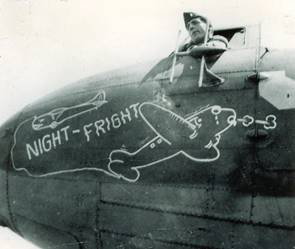
The aircraft’s crew at the time of arrival in England consisted of from left to right; Pilot 1st Lt. William K. Watson, Copilot 1st Lt Frank Bibas, Crew Chief T. Sgt Owen W. Voss, Radio Operator S. Sgt Robert S. McKnight (far right) and Hap the Cocker Spaniel, otherwise known as ‘General Happiness’. Hap arrived with his owner, Frank Bibas when the crew met at Fort Wayne, Indiana, to collect the aircraft. He flew on many missions, finally flying all the way home again, a military no-no that seems to have been overlooked every step of the way as he had become part of the Squadron by all accounts! The 436thcomposed of 79th TCS coded ‘S6’, 80th TCS coded ‘7D’, 81st TCS coded ‘U5’ & 82nd TCS coded ‘3D’. In March the Group moved from Bottesford to Station 466 at Membury, Wiltshire situated between Swindon and Newbury.
During the build-up to the Invasion of France the 436th took part in many training missions and simulated practice operations, such as the review of the 101st Airborne Division which took place on March the 23rd at Welford Park for Winston Churchill and General Eisenhower, nine planes being supplied by each squadron, one being Frank Bibas’ aircraft which dropped members of Fox Company of the 506th Parachute Infantry Regiment. Throughout May the Group took part in numerous training missions, usually carried out at night, one such mission being Exercise Eagle. At the end of another training mission the C-47s started to peel-off to land when a red alert was sounded due to enemy aircraft in the vicinity. All lights on the airfield were immediately extinguished leaving the pilots to circle and decide their next move, constantly on-edge trying to avoid other aircraft, especially those that were hostile. A decision was made and the C-47s started to land, without the aid of runway, perimeter or their own landing lights, all making it safely.
C-47s of the 85th TCS from Ramsbury trained with the Squadron during a number of these para-drop missions as they were to join the 436th Serials for the upcoming invasion. Soon before D-Day the aircraft gained the nose art of ‘Night Fright’, a play on words with the Antoine de Saint–Exupéry book ‘Night Flight’which was a favourite of Bill’s, see photo on following page.
Paratroopers of the 1st Battalion 502nd Parachute Infantry Regiment, the 377th Parachute Field Artillery Battalion and a detachment of the 326th Airborne Medical Company arrived at Membury in late-May to make their preparations for their part in the Invasion. Briefings took place with the troops and the aircrews being instructed on the routes, timings, drop-zones and known anti-aircraft gun positions and on the 3rd of June orders were issued for the ground crews and any available flight crews to paint black and white stripes on the rear fuselage and wings of all the Group’s aircraft. On the planned departure day of the 4thof June the weather forced a 24 hour delay, meaning that Operation Neptune finally went ahead on the 5th. Para-packswere assembled ready to load on to the six racks beneath each aircraft. The packs contained parts of the broken-down field guns; see photo below, ammunition, explosives, firearms and other equipment. Other packs including the howitzer wheels were loaded into the aircraft ready for the troopers to push out when the green light was turned on over the DZ.
The current view from Crisbeq battery down towards Utah Beach and the area in which ‘Night Fright’ dropped her troops.
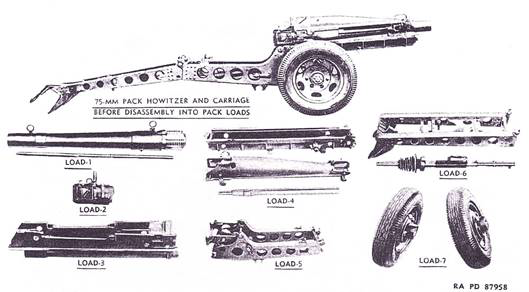
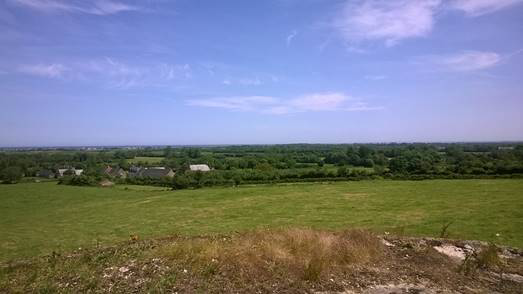
General Eisenhower visited the Station with the 101st Airborne Division Commander General Maxwell Taylor on his way around many TCC airfields on the 5th of June, shortly before departure for Operation Neptune. ‘Night Fright’ flew as Chalk No 38 in the second of two serials, #9 and #10 carrying 1084 troops that took-off from Membury at 2300 hours, carrying elements of ‘A’ Battery of the 377th Field Artillery Battalion at 0108hrs on 6th June 1944. The crew consisted of Pilot; William Watson, Co-pilot; James Hardt, Radio Operator; Robert McKnight, Navigator; Arthur E. Thornton and Crew Chief; Owen Voss. The lead vee of Serial #10 comprised 79th TCS C.O. Col. Kreyssler in ‘S6-T’ ‘Baby’ 43-15358 leading, Frank Bibas in ‘S6-R’ 43-15068 ‘Miss Hap’ on the left and ‘Night Fright’ on the right of the vee. Kreyssler’s aircraft had recently arrived with the squadron, it being a modified aircraft fitted with SCR717 navigation equipment which was ferried over from the US by Barney Welton who flew as Kreyssler’s co-pilot for Neptune. The remainder of the serial consisted of the remainder of the 79th & 80th TCS’ with the 85th TCS from nearby Ramsbury supplying aircraft to complete the final vees of the formation.
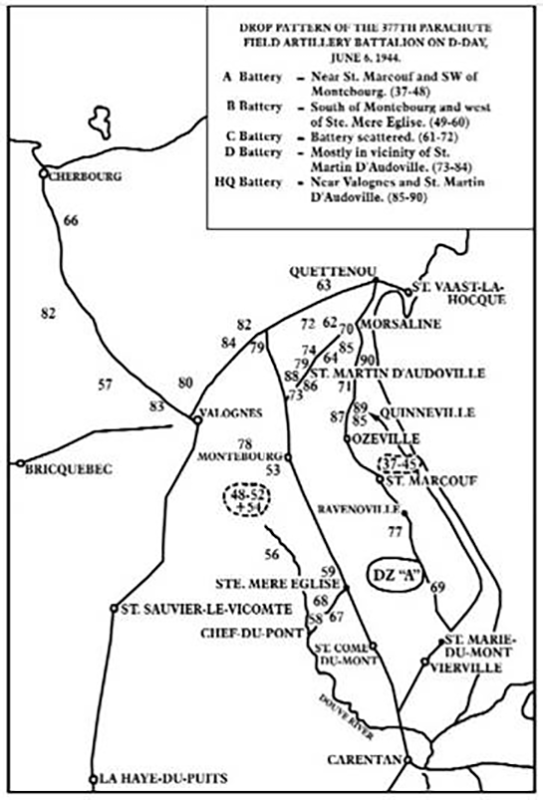
Many of the groups of Pathfinders encountered difficulties in setting up their homing beacons due to enemy troop concentrations, ground conditions, lost or damaged equipment and mis-drops. This meant that when serial #10 encountered heavy anti-aircraft fire and an unexpected cloud bank over the west coast of the Cotentin peninsular, their subsequent drop was widely scattered, as were a number of other such drops on the night. Chalk #38 most likely landed in a group with nine other sticks just to the north of St-Marcouf, some five miles north west of the intended drop zone ‘A’, which should have been set up to the south-west of Saint-Martin-de-Varreville but was actually set up close to Foucarville, a mile north of the intended location. The drop pattern map left shows just how scattered the unit was reported to have been, based on de-briefing reports taken from the Paratroopers upon their return to England, though this has been a contentious issue between the Troop Carrier members and Paratroopers ever since.
Another problem came about when the packs that were to be pushed out prior to the troopers exit got wedged into the door frame on a number of aircraft, resulting in the troopers landing far from the DZs or requiring the aircraft to make additional passes and therefore increasing the risk of being hit by ground fire. One trooper witnessed a C-47 making three passes in trying to place its troopers on the correct spot. After a less eventful return flight, the Group’s aircraft all returned to Membury by 0353hrs.
Mission Elmira was planned for the late evening of the 6th June. Serial 32 of consisted of two CG-4As and forty-eight Horsa gliders towed by the 436th TCG, departing from Membury at 2037hrs (Double British Summer Time) meeting the 363rd Fighter Group’s P-51Bs over St. Alban’s Head and taking a bearing for the route to LZ ‘W’ between St. Mere-Eglise and Carentan. The gliders carried members of the US 82nd Airborne Division’s 319th Glider Field Artillery Battalion, the 307th Airborne Medic Company, ‘A’ Company of the 307th Airborne Engineer Battalion and the 82nd Airborne Division Artillery. Unfortunately many of the gliders were released prematurely and some landed in or close to German-held territory at around 2300hrs as the sun was close to setting. Many of the gliders and C-47s encountered heavy ground fire after having to fly over German-held territory, leading to three aircraft from Serials 32 and 33 being forced to ditch in the Channel on their return.
Fortunately for the 436th all of their aircraft returned to Membury, albeit many having sustained damage, Night Fright herself taking around one hundred hits, putting her out of service for repairs for four days. The Group’s glider pilots were not so lucky, out of the the seven men lost by the Group, the 79th TCS lost 1st Lt. John Walls and 2nd Lt. Richard Hoag, both due to ground fire, with a number of others injured. Between the 9th and 13th of June the 436th carried out a number of sorties, towing CG-4As for resupply and troop movements to LZs near St-Mere-Eglise.
After repairs were completed a few days later Night Fright returned to service to carry out resupply missions, medical evacuations and freight-moving flights during the rest of the month.
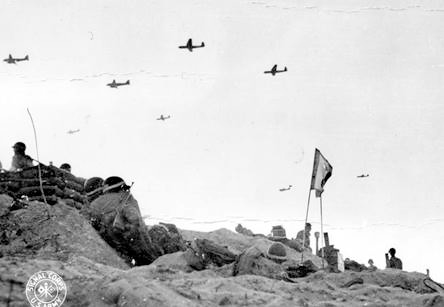
Horsa gliders towed by C-47s fly over Utah beach on their way to the LZ.
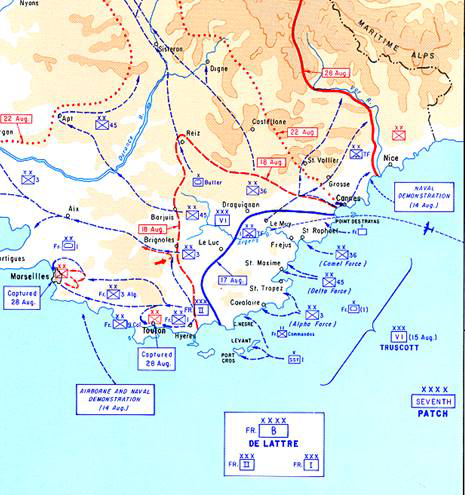
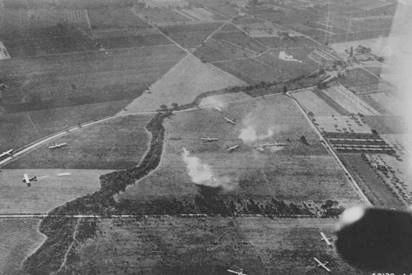
Gliders land in fields near Le Muy during Mission ‘Bluebird’.
Invasion of the South of France – Operation Dragoon
By early July, plans drawn up long before ‘Overlord’ were rewritten to open up the Southern coast of France. Originally called Operation Anvil the plan later evolved into Dragoon. The group’s part in Operation Dragoon meant that only a skeleton staff was sent with the forty eight C-47s, twelve from each Squadron, via-Marrakesh to Voltone airfield on the coast, forty miles north-west of Rome, forty nine aircraft being assigned from the Group.
On the 15th of August CG-4A gliders were loaded with members of the British 64th Light Artillery Battalion who were to provide artillery support to the British 2nd Paras. The 436th towed them to Landing Zone – O, east of La Motte, in Provence, on Mission Bluebird, where the formation circled for an hour over the Riviera coast due to heavy fog over the LZ which entailed the transmission of a recall message en-route, thankfully in that time the fog burned-off and allowed them to release their gliders at around 9:30am onto the crowded fields below.
During Dove, the follow-up glider mission, the 436th towed some of the 332 CG-4As to LZ-A and LZ-O, many of the gliders landing wherever they could into vineyards and trees due to the congestion over the Landing Zones.
The Group’s detachment of aircraft returned via-Gibraltar to Membury, on the 24th of August, showing off their tans and leading to the group diarist to write that it made the members who had remained in England “look like sick call”.
Operation ‘Market-Garden’
Market-Garden came about mainly due to the lengthening supply lines from the Normandy beachhead which were slowing the advance of the ground forces to a fraction of what they had been accustomed to over the past couple of months, instead of measuring daily progress in tens, or hundreds of miles it was sometimes counted in yards by mid-September. For the German forces it was having the opposite effect on the supply situation, they were now close to their own border and the industrial heartland of the Ruhr Valley, the priority in Montgomery’s eyes during planning for the operation and during his attempts to influence General Eisenhower to approve the operation, however with the Germans fighting so close to the ‘Fatherland’ there could be little hope that they would just roll-over.

The build-up for Operation Market-Garden involved the usual freight and gasoline hauling missions to the front-line, a number of hastily planned practice missions and also a few Operations that were scrubbed at the last minute due to the Allied armies overrunning the objectives of these missions. Briefing for the first Market mission took place by Membury control tower early on the 17th September, Lt. Col. Williams going over the plan and routes to the crews from up on the balcony. The Mission objective was to paradrop 390 members of the 506thParachute Infantry Regiment of the 101stAirborne Division from two serials of C-47s designated ‘A-12’ and ‘A-14’ to DZ ‘B’ north of Son in Holland, close to the bridge over the Wilhelmina Canal which was the first major objective for the Operation. Col. Robert Sink would be jumping from Maj. Adriel Williams’ C-47. Many of the 436th glider pilots were assigned to other groups for this first mission, therefore missing the follow-up missions during the next few days. Some, like Edward Griffin, did not make it back at all, his CG-4A took-off from Chilbolton, being towed by a 442nd TCG C-47 and ditched in the North Sea, breaking his neck but saving the lives of the troopers on board by making a good landing on the water. The
weather was murky as the aircraft started to take-off from Membury at 10:30, patches of rain and mist dogged the formations on the southern route flying from their bases to the RV point over Hatfield, flying north of London prior to turning south-east over point ‘Attu’ at Bradwell and heading for point ‘Borneo’ over North Foreland, crossing the Belgian coast near Ostend and picking up further escorting fighters. After turning at Ghent the formations of transports headed for the town of Geel where they made their final turn prior to hitting the drop zones.
After crossing the lines the crews started to see Dutch civilians waving to them below but their attention soon changed when around mid-way along the run-in to the DZ flak started to burst among the aircraft, the aircraft on the Northern Route suffered high casualties after having to fly for long distances over enemy-held territory to the DZs around Grave, Nijmegen and Arnhem so even though the crews on the Southern route may have felt themselves luckier than those not heading towards Son they still suffered a number of casualties.
One of the 80th TCS pilots, Rip Collins, reported that a C-47 ahead had been shot down and the burning wreck left a smoke-trail leading to Eindhoven, there was mention of it being the victim of an Me262 jet though the author can find no such claims for this period.
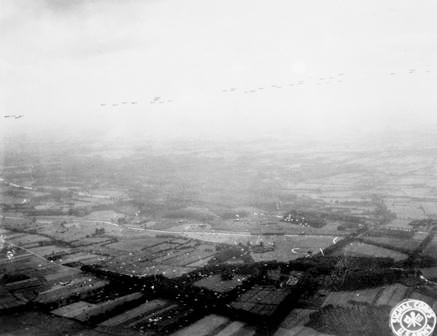
Troopers being dropped from C-47s at DZ-A1 close to Heeswiik Castle to the West of Veghel while aircraft flying the Northern route make their way towards their DZs near Nijmegen and Arnhem.
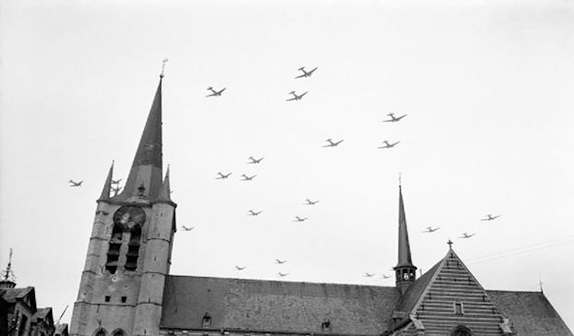
C-47s pass over Geel on their final leg to the DZs near Eindhoven.
The 79th TCS suffered two losses, both occurring over the DZ, Robert Stoddart’s aircraft, ‘S6-E’ 42-100522 (Night Fright’s sister ship) was hit as the troopers rose from their seats to hook-up to the static line, unfortunately the left wing caught fire, no doubt after being hit in the fuel tanks and requiring the order being given for troopers and crew alike to bail-out through the blazing inferno outside the exit door. Alas there were no survivors from the aircraft, Stoddart stayed at the controls to give the others a chance to bail-out, sacrificing himself when the aircraft crashed into a wooded area and burned-up a few hundred yards east of LZ-W. Ross Hanna in ‘S6-J’ 42-100527 “Cherokee Strip” crash-landed on the edge of the DZ, thankfully without any casualties.
The 436th returned to Membury to lick their wounds and patch-up their battered Skytrains ready for further missions to transport the remaining Airborne units. The 18th of September dawned foggy, both over England and the Continent. The plan had been for a 7:30am take-off, towing gliders containing 2nd Battallion of the 327th Glider Infantry Regiment and the 326th Airborne Engineers Battalion along with Medics of the 101st Airborne, along the Southern route to LZ ‘W’ in the same area north of Eindhoven where they had dropped troopers of that division the previous day. The take-off had to be postponed until the weather along the route had cleared sufficiently, so at 11:30am the first aircraft started their take-offs. Information from the continent warned of bad weather over the Southern Route which required a last-minute change to that of the Northern route. This delay turned out to be a stroke of luck as the Germans had counter-attacked and had taken areas of the LZs and DZs between Best and Son only to be driven back by stiff resistance by the 505th PIR who won a Presidential Unit Citation for their actions in driving back the counter-attacks.
Bad weather wreaked havoc again the following day when another glider-tow was planned to LZ ‘W’. Twenty one C-47s departed Membury towing gliders containing 155 airborne troops and 34,000lb of supplies but only four reached the LZ after the formation scattered due to the weather closing-in over the Channel. Further resupply missions were carried out on the 23rd and the 25th. Training and resupply missions to various airfields on the continent with medevac and POW flights by return concluded the month’s efforts.
October and November brought further supply runs and medevac missions along with copious amounts of rain and bad weather, the only highlight being that the weather cancelled flying on Thanksgiving, meaning that the crews could enjoy a meal together in the relative comforts of the mess rather than eating “K” rations on a soggy French field.
December started badly for Night Fright. On the 9th she had to return to Membury after an engine failure on a flight to A-79 Prosnes with a load of diesel fuel, resulting in both engines being changed which was completed by December the 13th.
Operation ‘Repulse’ – Bastogne
After the failure of Market-Garden, the Allies found themselves in the classic battlefield situation of over-extended supply lines as they had failed to open up a port closer to the front line, requiring the supplies to be brought in from the area of the Invasion beaches and ports by road, rail or barge along with the efforts of the ‘air bridge’ from the UK which had kept many of the Troop Carrier and Transport groups busy during the period from late-September to mid-December although the weather tried it’s best to intervene in their efforts.
With the capture of Antwerp and clearing the Scheldt estuary, completed in late-November, Hitler and his high-command planned an offensive to recapture the port and to encircle the armies in the salient that had formed in the line after Market-Garden. By using the tried-and-tested method of attacking the Allies via the Ardennes region, the Wehrmacht had targeted the small Belgian town of Bastogne as the key to unlock the Allies’ grip on the Western Front. Unfortunatley for them the 101st Airborne Division stood in their way and in order to assist them the High Command ordered the Troop Carrier units to carry out resupply missions to “The Battered Bastards of Bastogne”.
The 436th played their part in during three resupply missions to Bastogne which took place on the December the 23rd, Christmas Eve, Boxing Day and again the following day, dropping parapack and cargo door bundles from the aircraft, some of which sustained flak damage in the process. After the final mission the Group’s aircraft were forced to land at A-41 Dreux, home of the 441st TCG, due to bad weather over England which finally relented after a couple more days. December concluded with more resupply and medevac missions to and from the Continent.
January, February and early March brought further supply runs and casualty evacuation to and from the front lines along with an increasing number of training missions. February also brought a change of base when the Group moved to A-55 at Melun/Villaroche, some 25 miles or so south-west of Paris on Valentine’s Day 1945.
Operation ‘Varsity’ – The Rhine Crossing
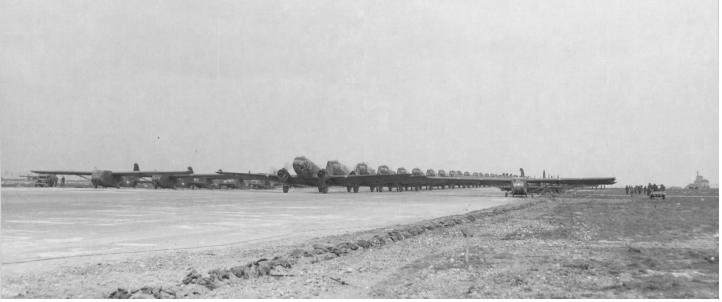
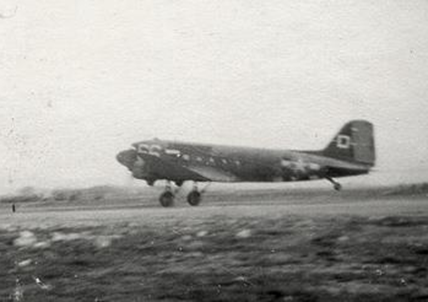
The 436th TCG lined up on the runway at A-55 at Melun on the 17th of March 1945 ready to depart on a training mission prior to Operation Varsity.
On the 24th of March 1945 the 436thtowed CG-4A gliders carrying members of the US 17th Airborne Division in serials A-10 & A-11 to Landing Zone ‘S’ for Operation Varsity.
‘S6-D’ starting her take-off run at Melun with a pair of CG-4A gliders in-tow on the 24th March for Operation ‘Varsity’, note in the foreground the fabric covers discarded from the Trooper’s weapons.
‘Night Fright’, as ‘Chalk – 51’ and flown by her regular crew Captained by Bill Watson, towed the gliders of Warner D. Ferguson, pilot / Donald J. Tracy co-pilot glider serial: 45-6155, Chalk #101 and David E. Haggard, pilot / Joseph J. Rice co-pilot, serial: 43-43304, Chalk #102. The 5th vee of serial A-11 comprised of the C-47s of Capt. Ross P. Hanna in 42-100519 ‘Captain and the Kids’, ‘Night Fright’ and Maj. Hollis B. Tara in 42-100529. The Group battled their way through severe flak to LZ-S where both gliders were released then carrying out a wide turn to the south-west when Hanna’s aircraft was hit by flak and failed to complete the turn post-release turn with the rest of the formation, last being seen heading into the haze and smoke over the combat area with three parachutes coming from the aircraft, the crew all being listed as missing-in-action until May when all but Robert Benton were found to have been taken prisoner, Benton unfortunately being killed. Losses could have been much worse had eight of the Group’s C-47s not been fitted with self-sealing fuel tanks prior to this operation. Varsity was the largest and also the final Allied airborne mission of the war in Europe and it paved the way for the race to Berlin which Montgomery had been hoping to achieve with Market-Garden six months before. During April the group were flat-out trying to keep up with fuel demands for Patton’s tanks, bringing a Squadron record 2,175,555lbs of freight to the front along with 5090 casualties and ex-POWs being returned, while also moving the 40th Field Hospital from Y-83 at Limburg to an landing ground close to the front line. On May the 8th hostilities ended with the acceptance of the unconditional surrender of German forces and thus begun the 79th’s busiest month for evacuations with 7826 POW’s and wounded soldiers being carried by the units aircraft. June was less busy with only 385 evacuations being made which paled in comparison to the news that the unit would be posted back to the US by the beginning of July. Bolero tanks were fitted to the aircraft and other preparations made in readiness for the long-range flights. One highlight was the sight of a number of Col. Watson’s “Whizzers”, no relation to Bill. These were captured Me 262s being ferried to Cherbourg for shipping to the US for evaluation like many other captured types, the 436th crews all being warned to be on the look-out for them as they would be flown by German pilots, non-radio. Right; Gen. Spaatz looks over the pointy-end of the Me 262 “Narwhal” at Melun with it’s ‘owner’ Col Watson looking-on under the guidance of Col. Williams
On July the 10th the 79th TCS set off on their journey back to the US returning via the same route they used to enter the ETO in early 1944, ending their journey at Hunter Field, Georgia on the 19th of July. After 30 days leave they returned to the 436’s new base at Malden, Missouri where more senior members were asked to help newer members get up to speed prior to their discharge. In the meantime ‘Night Fright’ had a maintenance check carried out at Romulus Field to the west of Detroit at the end of July prior to returning to the 79th shortly thereafter while the unit disbanded after the Japanese surrender on August the 15th was announced. The remnants of the group, including ‘Night Fright’ were absorbed into the 434th TCG by early October and shortly after the aircraft was declared surplus, being flown to Walnut Ridge airfield, Arkansas for sale or disposal.
In 1946 the aircraft, now registered as NC65384 was sold to Executive Transport Corp. of Texas who initially failed in their attempt to sell the aircraft to Penn Central Airlines, instead selling her to Northeast Airlines in June 1947. Her time with Northeast lasted less than a year before being bought by Piedmont Aviation who christened her ‘Tidewater Pacemaker’ as shown in the photo left. After four years service the aircraft suffered a mishap in gusty conditions at Greensboro, North Carolina on October the 20th 1952 as Flight 20 but by late the following March she was flying again, this time registered as N45V. Three more years safe service followed before a drunken passenger fell to his death, near Shelby, North Carolina as Flight 5, mid-way between the departure point of Charlotte and the destination at Asheville on June the 13th 1956. Charlotte Aircraft bought the aircraft on February the 28th 1962 but by the end of the year it was put on the market again.
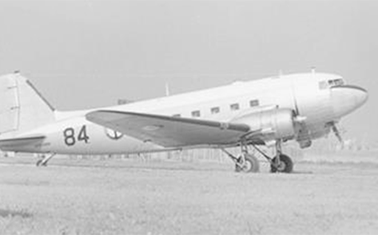
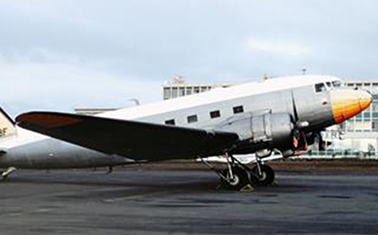
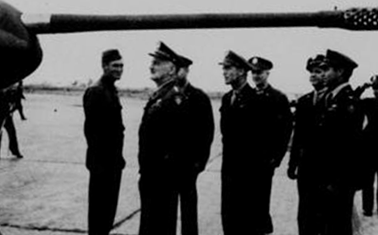
‘521 as N98BF photographed at Reykjavik in September 1985 on her journey back to the US after being acquired by Basler Flight Services, Wisconsin. Photo; Baldur Sveinsson
In March 1963 the French Navy purchased the aircraft as part of a drive to replace their Beechcraft JRB-4 trainers, ferrying her back over the Atlantic to Le Bourget for overhaul and modification work to be carried out by SECA. At this time Escadrille 56S was based at Nimes-Garons, near the Southern coast of France where they trained all non-flying maritime patrol personnel. The modifications carried out to the cabin in particular provided working areas for the trainee crew members, repositioned the astrodome aft to the cabin area and upgraded the avionics. She joined Escadrille 56S as ‘18984’, Ship #84 with call signs ranging from F-YGGG, F-YGIA, F-YGGF. On navigation exercises she flew as far afield as Malta, visiting Luqa airfield on 17 June 1969 and again on 20th April 1970 as shown in the photo left (Peter Marson Collection).
By 1984 most C-47s in military service had been retired and this was the case for Ship #84 which passed into the ownership of Nimes Garons (France) in May 1985 and then on to Basler Flight Services of Oshkosh, Wisconsin who registered her as N98BF in Septembe
r of that year. Ferried to the US via the Northern Route
Soon after her return to the US the aircraft was bought by Aircraft International Charters of Conroe, Texas who swiftly sold her on to Sky Freighters Corp. of Grand Prairie, Texas in December 1985 and registered N308SF, photo below (Zane Adams).
After four years cargo hauling with Sky Freighters N308SF passed into the hands of Belle Meade Air, Inc. of Nashville, Tennessee who operated her for three more years.

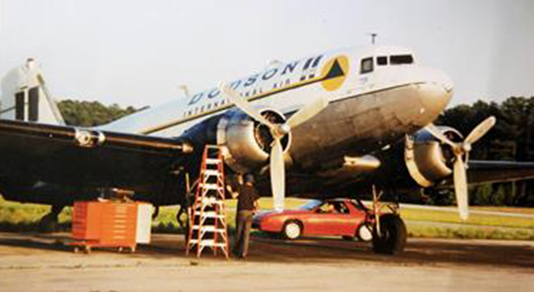
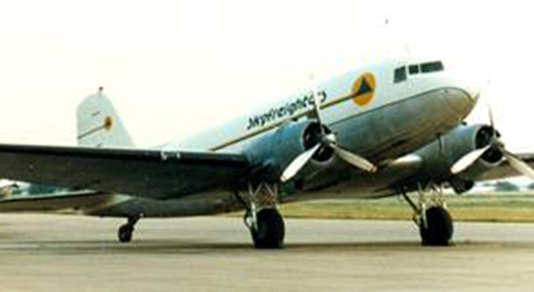
In late July 1992 Dodson International Air of Oxford, Georgia became the new owners of ‘308SF. They used C-47s to fly freight around North, South, Central America, and the Caribbean for various charters, the photograph right was taken at Covington, Georgia in 1999 (Photo; Alex Waning APVW videos).
One of her pilots whilst with Dodson, Daniel McDevitt, now a Captain with Delta, sent the photo left showing his father-in-law completing maintenance prior to departure for another freight hauling trip to the Caribbean or a country in the in the Gulf of Mexico. The load could consist of anything from chickens to electrical generators, especially around the hurricane season!
After ten years service with Dodson, ‘308SF was purchased by BS&J Leasing of Hopkinsville, Kentucky in October 2002. This company were affiliated with Tuckasee Air Cargo of the same address, as pictured in Brad Harris’ photo below taken at Knoxville, Tennessee with one of her former Dodson stable-mates.
By September 2007 the aircraft was to be found with C.J. Aviation Services of Greensboro, North Carolina where she had suffered her mishap whilst with Piedmont all those years ago. Three unsuccessful attempts were made by C.J. Aviation to sell the aircraft on E-Bay, initially for $150,000 and finally for $88,000, the highest bid being $50,100 in July 2008. A short while after the aircraft was sold on to Universal Asset Management INC, on the 30th of August 2008 who have a long history in aircraft dismantling and salvage which could have proved fatal to ‘308SF but fortunately she was spared the scrapper’s torch for a few years.
In 2012 the author’s then boss, Tony Bianchi, put him in contact with the owners of the Membury Estate in Berkshire, the Walker Family, who were looking for an aircraft that had flown from the airfield in World War 2. Originally the brief was to find a suitable aircraft for static display but Charlie showed enthusiasm when told of the possibility of finding an airworthy machine. After narrowing down the likely candidates the author discovered the E-Bay auction for the aircraft from 2007 and traced the flights she had made in the last few years and found the bases operated by Universal Asset Management. After searching Google Earth for a few hours the shape of a C-47 revealed itself on the apron at Walnut Ridge, Arkansas, the very airfield that she flew into at the end of hostilities on October the 30th 1945 when transferred to the Reconstruction Finance Company by the US Air Force, the aircraft had gone full circle and had 52,000 hours on the clock to prove it! In December 2012 the aircraft was purchased by Philip & Charlie Walker of Membury Airfield, Berkshire, England and moved from Walnut Ridge, to Punta Gorda Florida where the wings were removed to allow for road transport to Shell Creek, Florida for refurbishment to commence. Even though she was converted to cargo configuration and the interior bulkheads were removed, most likely while in service with the French Aeronavale, the aircraft still retains a number of rare features including all of the exterior formation-flying lights and many patch-repairs due to battle damage received during her Air Force service.
In 2016 Clive Edwards and Gordon Gray prepared the aircraft, still in an unfinished state, for containerisation and shipping to the UK, this was completed in March 2016 and Night Fright is now back in England with the restoration team led by Ben Cox at Coventry to return the aircraft to the sky and to her WWII colours. Eventually part of the runway at Membury might be restored to allow her to operate from her original WWII airfield, the only C-47 in the World to do so.


